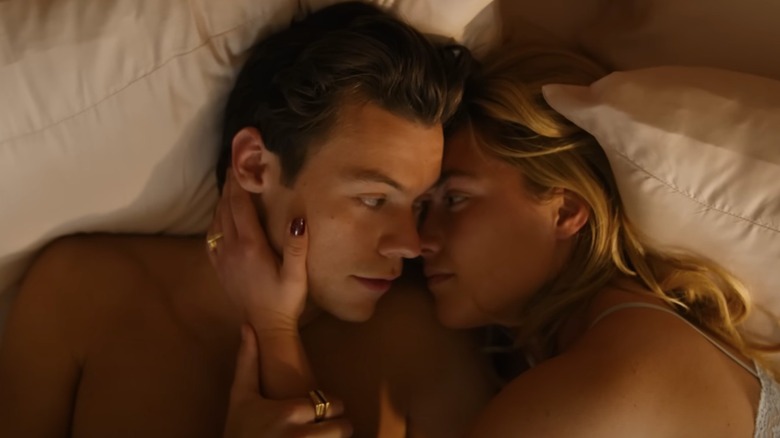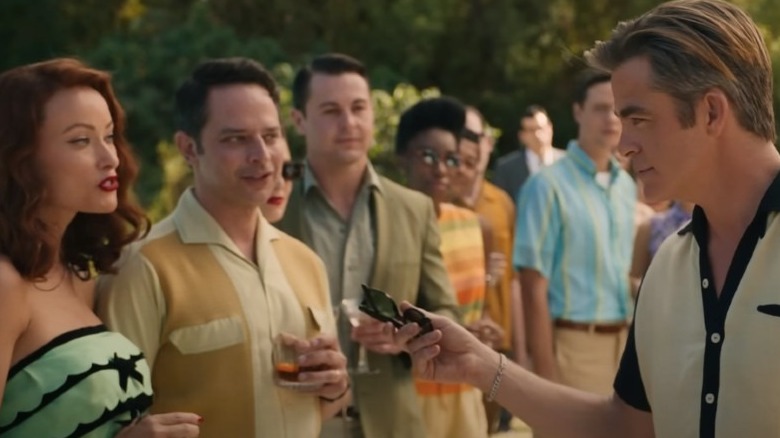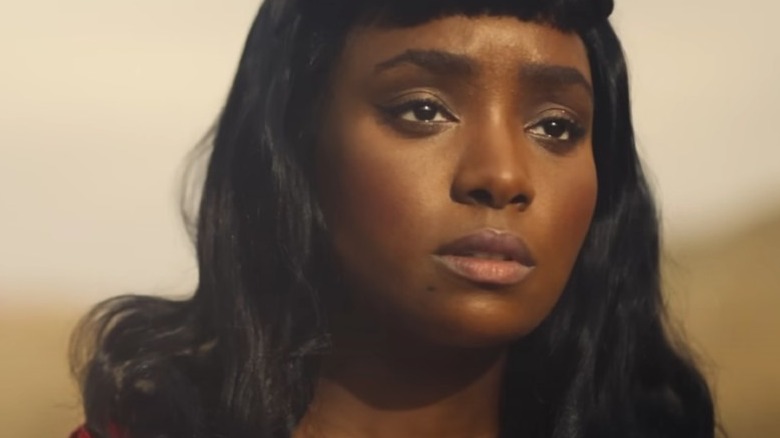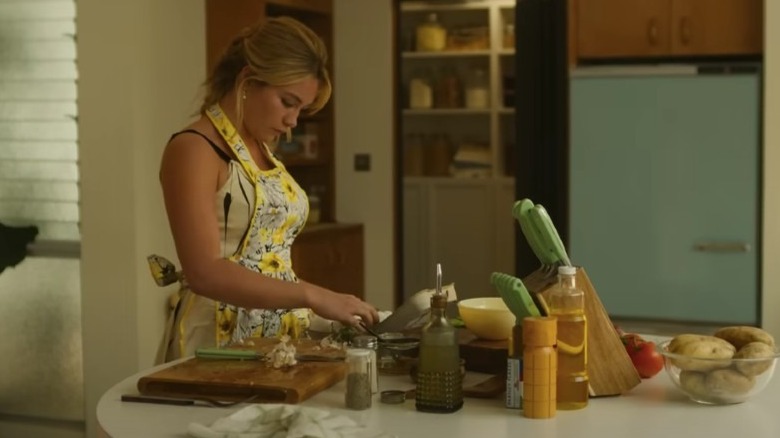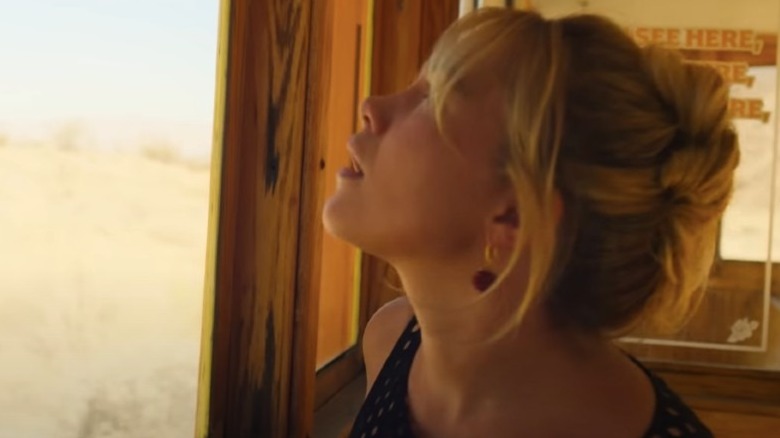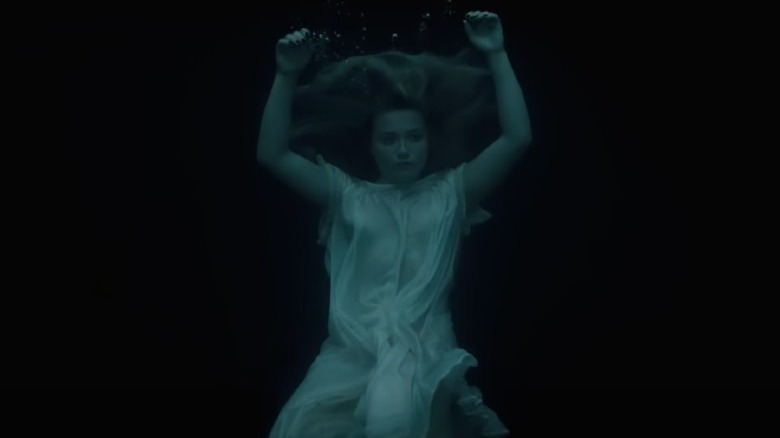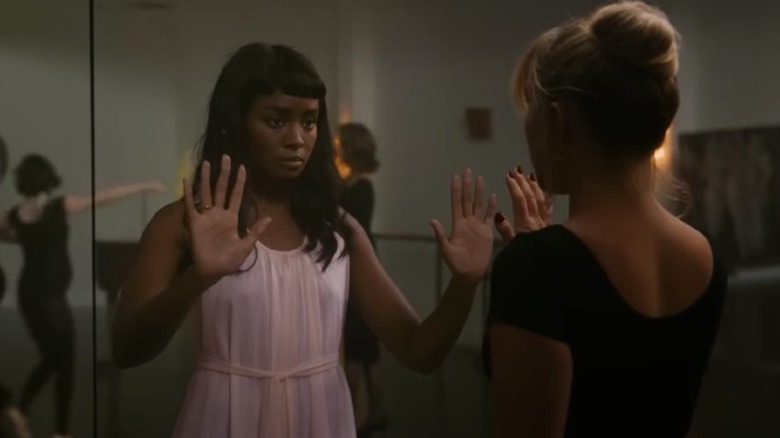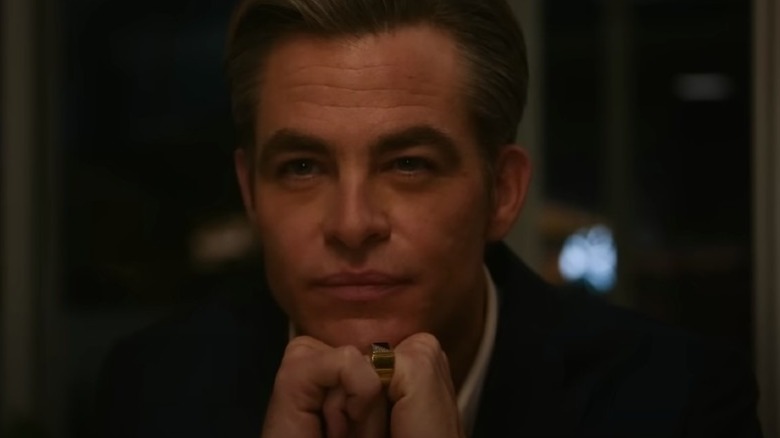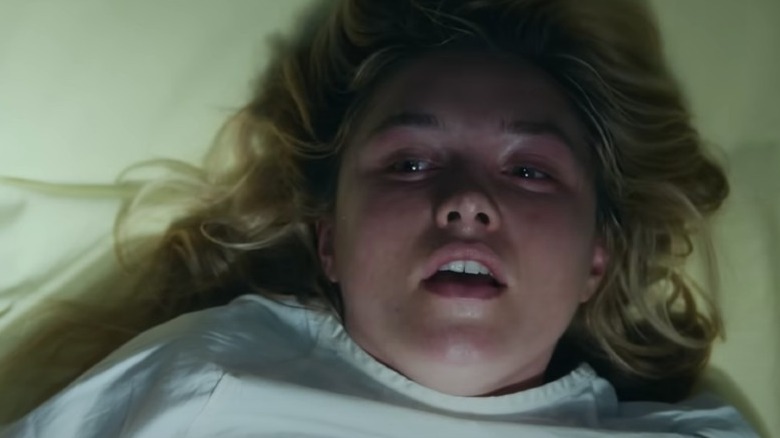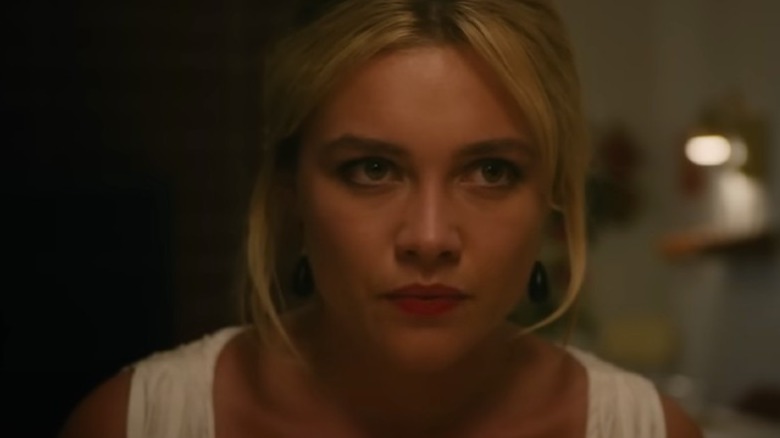The 10 Most Unsettling Moments In Don't Worry Darling
"Don't Worry Darling" may have failed to impress overall, but it still offers plenty to discuss, including the bonkers ending. Themes about womanhood, autonomy, and technology knot together, accentuated with a dazzling performance from Florence Pugh as Alice. Harry Styles stars opposite as her workaholic husband Jack, alongside a cast that also includes director Olivia Wilde (as Bunny), Chris Pine (as Frank, founder of a community called The Victory Project), and KiKi Layne (Margaret). The tight-knit community, straight out of a 1950s copy of American Homes and Gardens magazine, is too pristine for its own good. As they say, if it's too good to be true, it probably is.
Cinematographer Matthew Libatique brings a crispness to the visual storytelling, and when events take a turn for the worse, so does the cinematography. There's an especially suffocating dread that seeps into the edges in even the brightest of frames. As Alice loses her grip on reality, her mind wanders through bursts of hypnotically strange images that suggest something wicked is brewing beneath the surface. Throughout the film, the visual style directly compliments a growing unease and the characters' measured devolution. We've selected the 10 most unsettling moments in "Don't Worry Darling," from Alice's inescapable hallucinations to the big third-act reveal. Don't worry, darling, it's just a list, but do BEWARE OF MAJOR SPOILERS!
Discretion above all else
Frank, Victory Project founder, gives an insidiously chilling monologue to greet a new couple entering the community. Commanding the crowd, he asks one resident named Bill (Nick Kroll) about what the antithesis of progress is. Bill responds: "Chaos." Frank repeats the word, and then the others in a creepy cult sort of way. As Alice (Florence Pugh) will later point out, it's about control versus independence.
Frank continues to spout a charming yet eerie spiel about expectations men put upon women. From keeping a tidy home to making sure their husbands stay happy, it's a dystopian nightmare, but above all else, Frank and the men expect discretion. Discretion could mean a myriad of things, including what's really going on in headquarters or within each couple's residence. Sometime later, Alice and Jack (Harry Styles) steal away inside Frank's home. Jack fusses with his tie and Alice offers to help. Soon, they hook up in Frank's bedroom. The risk of someone walking in is of no real concern ... until Frank inches into the frame and watches them. He utters nary a word, only watching from a short distance. Alice notices, and Frank makes a "shhh" sign with his hand. If you need your first real red flag 一 ding, ding, ding! We have a winner!
The story of Margaret
Over garden cocktails, Bunny tells a haunting story of their next-door neighbor Margaret, who claims there's something dark and sinister at work in the community. The story goes that Margaret took her young son out into the desert, far from the residential block where Victory Project headquarters lies, and fell into a daze.
When she awoke, her son was gone, and Margaret believes they took her son away as punishment for stumbling upon their plot. The film excels in casting the audience right inside Margaret's head with hazy flashes depicting Bunny's words. It's as hypnotic a sequence as it is perfectly unsettling. There's also the implication that Margaret has been irreparably affected by living in the cookie-cutter community, from an emotional and mental standpoint. Yet no one is concerned enough to find out exactly what's going on, and that might be the most disturbing part of all.
Stepford Wives
The entire basis for the community is perfection and symmetry. The men leave for work at precisely the same moment every single morning. The wives vacuum their living rooms and the television set plays the same spooky cartoon. The days seem to topple into each other. One day doesn't feel much different from the next.
Even in dance class, everyone's movements are swan-like and in unison. "There's beauty in control," the instructor says. Striving for such excellence in every part of life should be upheld. When a new wife named Violet (Sydney Chandler) visits the class, a cloud of dread seems to fall across the other wives. At all costs, they must adhere to strict guidelines about presenting themselves, as evidenced when the instructor corrects Alice's posture and chin placement. Taking obvious influence from "The Stepford Wives," "Don't Worry Darling" boosts everything up a notch in the unsettling department. The cleanliness of the community isn't enough: The wives must be the picture of literal perfection.
Unexplained plane crash
Alice feels bored with life, so she takes the trolley out to town and then to the end of the line. While the driver makes a turn, Alice spots a lone biplane that's caught on fire and billowing spoke. She watches as it crashes into a faraway mountain, and her attempts to get the driver to follow are unsuccessful. "We need to stay here where it's safe," he says, repeating a concerning refrain found throughout the film.
Alice instead hops off the trolley and heads out on her own. She walks and walks and walks until she's in the same head fog that Margaret described. Hair disheveled and pouring sweat, she climbs higher and higher until she comes across a metal portal. She meets only glass windows and places her hands on the surface. Her mind is instantly thrown into a frenzy, as the cage surrounding her mental facilities chips away and she recalls long-forgotten memories. Frank's voice can be heard spouting "we crave order" over distorted images of 1920s dancers and other peculiar pictures Alice can't quite place. Almost in an instant, she wakes up back in her own bed at home as though nothing had happened. Jack is busy in the kitchen cooking up some pot roast and green beans, and he simply shrugs off her concerns as nothing more than a dream. The film can best be described as a gaslight hell.
Alice's Wonderland
Alice tumbles through a host of other weird and unexplainable trances. While cleaning one of their glass windows, a spot appears that won't come out. Alice scrubs and scrubs. Little does she know, the wall has begun closing in behind her. Picture frames dig into her back and nearly crush her skull. In a flash, her body jolts backward and it all fades away. Everything is as it should be. In another moment, she settles into the sofa in the living room to watch television. During a pool commercial, she spies herself flailing in the water and is quickly yanked into the water herself. She's not struggling, though, merely floating in another place, bubbles reversing into her nostrils. Once again, she seems to rouse from a waking nightmare.
Throughout the film, Alice goes through countless more mind trips. She nearly drowns in a hot bath after a total sinking far below, then later reaches a breaking point and wraps her head in Saran Wrap until she rips it back off. All these smaller moments are unsettling on their own, and piecing them into a larger puzzle gives greater psychological weight to her state of being as well as to what may actually be going on behind the curtain.
Margaret's tragic fate
Alice imagines seeing Margaret inside the glass walls during dance class in another hallucination. Margaret appears scared/anxious and slowly inches closer to the glass, mimicking Alice's every move in the process. At first, the viewer assumes that Margaret is possibly trapped inside Alice, but she quickly reveals herself as being her own person. Margaret then proceeds to bash her head repeatedly against the glass until it splinters into a web-like design.
Later that day, Alice spies Margaret on top of her roof and approaches her. As she screams her name, Margaret takes out a knife and slits her own throat, blood spurting everywhere. She then turns and flies back to the ground, dead. The doctor and the other powers that be later claim Margaret is quite alright and has been stitched up. Alice questions every point of their story, repeating over and over again what she witnessed. In a separate conversation, the doctor admits that Margaret has some severe mental problems that have led to permanent treatment somewhere outside the community. Margaret's death is nothing short of frightening, especially considering how easily the circumstances surrounding her story were swept under the rug. While KiKi Layne had limited screen time, her presence was captivating. Once she departed, her absence rang like a deafening siren.
Frank comes to dinner
"My god you fascinate me," Frank whispers to Alice. During a dinner party, Frank surprises Alice in the kitchen and tells her how long he's been waiting for someone to "challenge me." He then reveals his condolences that Bunny didn't believe her allegations that something's off with the Victory Project. Frank inches closer to Alice, telling her that he's happy she's "preparing dinner like a good girl." The moment is as gross as it is downright unnerving.
Later, Alice doesn't hold back when it comes to confronting the other couples. She begins by asking Violet how she met her husband Bill (Douglas Smith), and it becomes clear the romantic meeting (dropping her ticket and Bill bending down to pick it up) has been recycled with countless other newlyweds. This bombshell causes a ripple through the guests, most noticeably with Bunny, yet Frank eats up every single moment of it. Despite many reactions to the film, "Don't Worry Darling" delivers its commentary with relentless, sharp-toothed terror.
Abduction of Alice
After agreeing (quite reluctantly) to run away together, Jack sells out Alice to Frank in a devastating turn of events. Alice packed up a getaway bag and hopped in the car. Jack looks obviously dejected. Alice glances up to see men in red suits dashing towards them, much to her horror. She begs not to be hauled away and declares she'll be good for him. Like most of the film, Florence Pugh rips your heart out with her resounding screams alone.
Alice is taken to an undisclosed location and strapped into a hospital bed. Leather handcuffs dig into her skin, while she writhes and attempts to break free. She's then given electroshock therapy, a cruel punishment to wash away all her memories and what she knows about the Victory Project. Flickering between images, the recent past bleeds into Alice's distant past of working as a nurse and going home to a humble apartment in the city. Possessing long, stringy hair, Jack sits hunched over his computer and looks far removed from his clean-cut look in the '50s hellscape. In this scene, two things are suggested: Alice is right about everything, and something far more troubling is at play. We don't yet know the full extent of Frank's sinister world, but we will soon. It's already enough to make your blood run cold.
The Victory Project
The third act drops the ultimate twist: Not only is The Victory Project a facade, but it's actually an immersive virtual reality experience. In real life, Alice has been kidnapped and tied down to a bed with an electronic scanning device attached to her eyes. Believing her to be unhappy in life, Jack took her hostage and trapped her inside a simulated world to live a perfect existence. For their part, the men can only log a certain number of hours inside the simulation and are required to leave for work promptly at the same time every single morning.
The Victory Project is the ultimate gaslighting. The wives are hushed into submission and forced to adhere to traditional gender roles far removed from modern progress and liberation. The finale also reveals Bunny knew everything from the beginning, but she's unsure about the other wives. Unsettling doesn't begin to describe this revelation. It's a dystopian horror.
The final chase
All the chips are down when Alice kills Jack for what he's done, then runs for her life. She burns rubber in Bunny's car and zips off straight for headquarters in the desert. A slew of men in red suits charges after her. After causing a head-on collision between three vehicles, Alice furthers the distance between her and the others, eventually coming upon the metal gateway to the real world. When her car pops a tire, she makes her way on foot and barely manages to high-tail it up the winding gravel road.
Once at the top, she stops for a second before stepping forward and placing her hands on the glass. A red neon glow emanates from within and transports her consciousness back into her body. The screen cuts to black, and she heaves a sigh of relief and exasperation. She survives by the skin of her teeth. It's a moment of triumph, but it's not without a glistening edge of darkness. What about the other women? Do they finally get their own vengeance? With Frank dead, and his wife Shelley (Gemma Chan) reclaiming her life, it certainly seems The Victory Project is destined to burn from the inside out. We know better, though: Where there's one cis white egomaniac, there are a dozen more to take his place.
